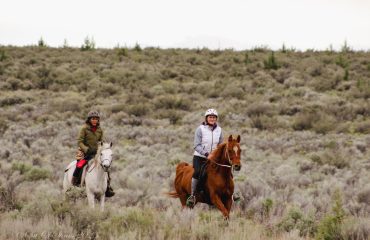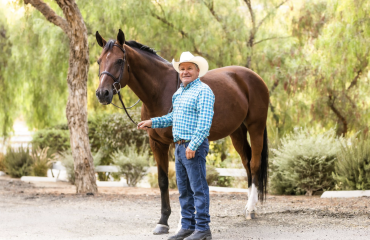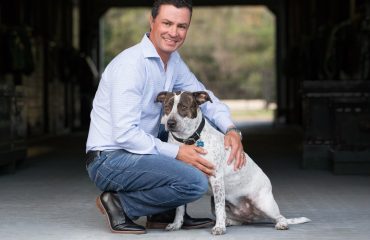
A small group of equestrian media members, including Sidelines’ very own Susan Friedland-Smith, had the ride-of-a-lifetime around the Rolex cross-country course. (Photo courtesy of Rolex)
By Susan Friedland-Smith
Never in my wildest dreams would I have thought I’d ever have the chance to ride the Rolex Kentucky Three-Day Event cross-country course during the “Best Weekend All Year” in April! Especially since I’ve had my horse for less than a year and I’m not an eventer. (Details, details!) Thanks to the five-star hospitality of the country’s lone four-star event, and as a Sidelines Magazine representative, I was able to join a team of media members on a sneak preview trail ride to see several sections of course designer Derek di Grazia’s masterpiece on the bluegrass.
A Distinguished Trail Guide
As if the honor of riding a horse on course at Rolex wasn’t enough, our trail guide was 2004 Olympic individual gold medalist for Great Britain, eventer Leslie Law. Following the end of the dressage day-one press conference, a posse of golf carts whisked us off to meet our mounts tacked up in Western saddles. Leslie greeted us sporting jeans, sneakers and a riding helmet.
I rode Rainbell, a chestnut mare with a long mane and white face. All of the writers had to sign waivers warning us that riding is inherently a dangerous activity and that we’d ride responsibly and only at a walk. I smirked thinking that our stroll around the jumps was probably pretty low on the scale of danger. Rainbell sporadically gave me a jig of a trot, but no one seemed to notice. It was a brisk spring day in Lexington and I too was excited!

Rainbell, the trail horse, and Susan aren’t ready to compete in any four-star events, but had a nice hack around the Kentucky Horse Park nonetheless. (Photo courtesy of Rolex)
Course Stats
On our ride we learned the start of the 2015 course was actually where the finish was the previous year, and that there were a number of new lines through the park to some areas where the Rolex course had never passed before. The optimum time was 11 minutes 6 seconds for the 6,400 meter route (almost four miles) consisting of 29 fences. Technically the horse-and-rider teams faced more than 30 fences during the cross-country phase as many of the obstacles were combinations with A and B elements and others, such as the Water Park (the one with the giant goose), featured A, B and C elements.
The town where I first learned to ride growing up outside of Chicago hosted a three-day event every summer so from early on I witnessed cross-country riding firsthand as both a fan and jump judge. However, this was my first time up close and personal with imposing four-star jumps. The highest of the solid obstacles was 3’11” (4’9” if you count the height of brush fences) and the maximum spread from the highest point was 6’7” and at the base 9’10”. The height, spread and narrowness of some of the jumps were jaw dropping.
Leslie’s Predictions
One such example was 16A of “Mounds” — the keyhole fence. Our trail group paused and Leslie predicted how the riders would navigate element B, which was three or four strides away, depending on what approach the riders would jump going downhill and back up an incline to an angled brush.
I grew up jumping logs, but none like fence 20, which was a 3’6” fallen tree complete with exposed roots and a larger-than-life acorn resting on top. Although the log seemed imposing from my vantage point on Rainbell, it looked like a cross rail compared to the Picnic Table, which was the maximum height and had a top spread of over 6 feet. I had a hunch that when the riders were galloping on course, they’d make it look effortless. My suspicions were proven correct when I stood on the sidelines in the rain on cross-country day with tens of thousands of other fans and witnessed the athleticism of the horses and riders.

Fence 20, which was a 3’6” fallen tree, seemed imposing, yet on Saturday the horses jumped it like a cross rail. (Photo courtesy of Rolex)
During our preview ride I noticed several fences were shrouded in white plastic. Another journalist said it was because it had been unseasonably cold and rainy, and the flowers had to be protected from frost danger. The cross-country flowers were “recycled” and used for the show jumping course the following day.
A Little History
At one point on the trail, I had the pleasure of riding alongside Leslie, who’s now based in Florida and is a popular clinician. I asked him how his riding career began. He said he started at age 10 and his brother also rode so it was a spirit of sibling competitiveness that motivated him early on.
I also asked him if, when riding cross-country, he noticed the fans cheering or if he is so focused on his riding that the noise isn’t noticeable. Leslie compared the crowd’s noisy support to background music. He gave the example that if I were writing a story on my computer and there was music, I’d be aware of it and probably think it’s nice, but it wouldn’t have my main attention. Leslie said that in the Olympics in both Sydney and Athens, the fans were very loud. He added that the cross-country fans were so loud for the London Olympics that the riders couldn’t hear their watches beep to mark the minutes on course.

Olympic gold medalist Leslie Law, third from left, escorted the riding writers on a preview tour of the Rolex Kentucky Three-Day Event cross-country course. Sidelines writer Susan Friedland-Smith is second from the left. (Photo courtesy of Rolex)
It was a thrill to meet Leslie and walk the course on horseback with the other media members. I’m in awe of the brave men, women and horses who competed at Rolex this year. It was enough for me to simply ride Rainbell and watch YouTube helmet cam videos of the 2015 cross-country phase but at least I still got to check one more item off the proverbial bucket list.













